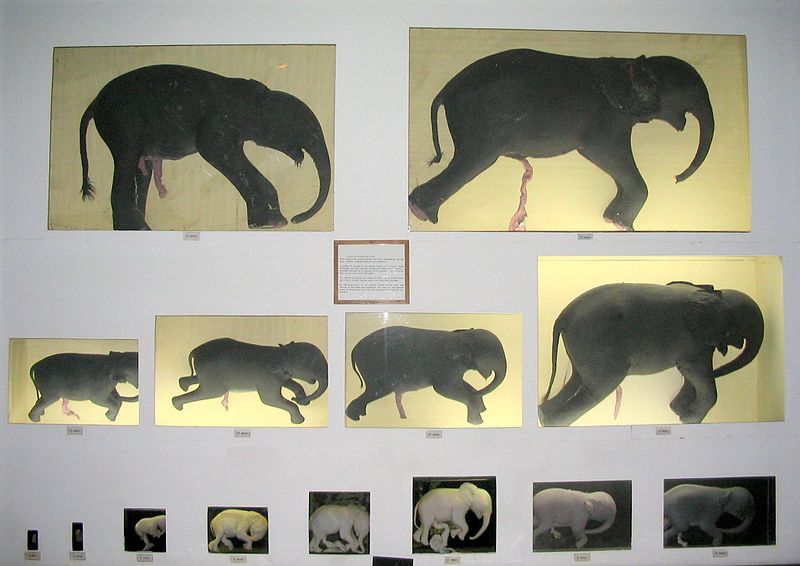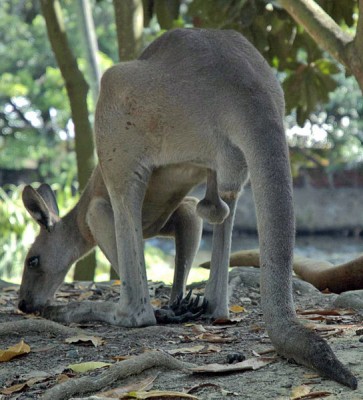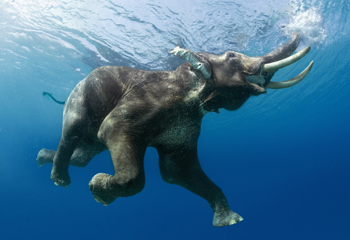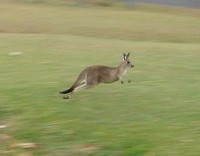Pausing on the bank, the lead female gathers her herd, ensuring that she is followed before she plunges in.
The smaller elephants swim, heads fully submerged. Others walk at first. All are snorkel-breathing through their trunks.
A lone male follows at a distance. He watches the tribe for a moment before he too enters the water.
Elephants are the largest land mammals, and are at home in hot, dry savannah environments. They migrate hundreds of miles in search of food, and when required will cross rivers, lakes, and even undertake marine excursions. They are surprisingly strong swimmers, and are the only mammals able to snorkel.
This provides a vital evolutionary clue to their past. Although we associate elephants with dry land, their bodies reveal clear evidence of an aquatic ancestry.
Fossils and DNA put elephants amongst the swimmers
DNA evidence:
Comparing DNA sequencesenables usto build molecular phylogenies, or ‘family trees’, defining the genetic relatedness between species. These phylogenies show that elephants’ closest living relatives are the fully aquatic sea cows; the dugongs and manatees.
Fossil evidence:

An artist’s impression of the semi-aquatic Moeritherium by scientific illustrator Heinrich Harder (1858-1935) (Image: Wikimedia Commons)
Water molecules (H2O) contain three isotopes of oxygen; 16O, 17O and 18O. The lighter forms evaporate more easily, slightly enriching lakes and oceans with ‘heavy’ water. This then can become incorporated into aquatic plants and the bodies of animals that graze on them. Analysing the ratio of ‘light’ 16O to ‘heavy’ 18O isotopes (i.e. d18O) in teeth from fossils of the extinct elephant ancestor Moeritherium, show that they contain a higher proportion of 18O than teeth from land grazing animals. This tells us that it ate mostly freshwater plants, suggesting its lifestyle was at least semi-aquatic.
Elephant embryos reveal adaptations to breathing under water

This photographic series of elephant foetuses shows the early appearance of the trunk. Natural History Museum, Maputo, Mozambique.An elephant foetus has detectable heart beats by day 80 of gestation, and the trunk start... mores to become visible at days 85-90. Overall, gestation is approximately 660 days (Image Wikimedia Commons)
Elephants can snorkel because of their elongated trunks, and elastic connective tissues that fill the space between their lungs and their body wall. Both of these features appear together early in the foetus, suggesting that they were important for survival of the elephant’s ancestors.
As in other large mammals, elephants’ blood pressure is high; this is needed to keep the brain well supplied with oxygenated blood. Under water, the differences between the pressure of inhaled air (atmospheric; 0mmHg) and the blood pressure in the capillaries (150mmHg) would be enough to rupture blood vessels and the delicate linings of the lung. Their elastic connective tissues act as shock absorbers, protecting the lungs against such damage.
Elephants’ testes are inside the body like other aquatic mammals

A male western grey kangaroo (Macropus fuliginosus) foraging near Port Douglas, Queensland. In hot weather, male kangaroos lower their scrotal sac away from the body; this helps keep these organs at a cooler temperature... more and avoids damaging their sperm (Image: Wikimedia Commons)
The location of a mammal’s testes is related to temperature. Excessive heat or cold will kill mammal sperm (including humans), causing sterility. Hence in puberty, boys’ testes descend into sacs that are slightly cooler than the interior of their bodies. However aquatic mammals continue to carry their testes inside their abdomen to protect them from cold. We would expect land-dwelling elephants’ testes to be carried in a scrotum. Instead, their testes remain inside the body like those of aquatic mammals.
Early in the foetal development of both male elephants and dugongs, an artery develops which directly connects their kidneys and testes. In contrast, the testes of most land mammals have a less direct connection, allowing them to descend into a scrotum during puberty. This suggests that like modern dugongs, the elephants’ ancestors lack a scrotum.
Aquatic mammals including dugongs have a plexus of blood vessels that cool their internal testes and uterus through a counter-current heat exchange mechanism. Testicular cooling by a blood plexus has not yet been investigated in elephants; however in the absence of heat stress, they maintain a body temperature of around 34-36⁰C, which is similar to the temperature of the scrotum in most other land mammals.
Elephants ears close for swimming

This skull (formerly from a zoo elephant, kept at Basle in Switzerland) has had a front (sagittal) section removed, to show the honeycomb of air cavities inside the bones. Elephants hear low frequencies (infrasounds) tr... moreansmitted through the ground and conducted to their skull and inner ears through the bones of their front legs. These sounds are amplified by resonating in these inner bone chambers (Image: Wikimedia Commons)
After swimming we often have to shake our head to clear water from our ears. However elephant ears have a unique sphincter-like muscle that closes the ear canal and prevents water entry when swimming. This also creates a sealed ‘acoustic tube’, which works with the aerated bones and ‘acoustic fat’ lenses of the elephant skull to amplify low frequency ‘infrasound’. Dugongs have similar aerated skull bones and fatty deposits; again implying that they share an aquatic ancestor.
Text copyright © 2015 Mags Leighton. All rights reserved.
References
Fowler, M.E. and Mikota, S.K. (eds) (2006) Biology, Medicine, and Surgery of Elephants. Blackwell.
Gaeth, A.P. et al. (1999) The developing renal, reproductive and respiratory systems of the African elephant suggest an aquatic ancestry. Proceedings of the National Academy of Sciences, USA 96, 5555-5558.
Hildebrandt, T. et al. (2007) Foetal age determination and development in elephants. Proceedings of the Royal Society of London, B 274, 323-331.
Johnson, D.E. (1978) The origin of island mammoths and the Quaternary land bridge history of the Northern Channel Islands, California. Quaternary Research 10, 204-225.
Johnson, D.E. (1980) Problems in the land vertebrate zoogeography of certain islands and the swimming powers of elephants. Journal of Biogeography 7, 383-398.
Liu, A.G.S.C. et al. (2008) Stable isotope evidence for an amphibious phase in early proboscidean evolution. Proceedings of the National Academy of Sciences,USA 105, 5786-5791.
McKenchie, A.E. and Mzilikazi, N. (2011) Heterothermy in Afrotropical mammals and birds: a review. Integrative and Comparative Biology 51, 349-363.
O’Connell-Rodwell, C.E. (2007) Keeping an ear to the ground: seisemic communication in elephants. Physiology 22, 287-294.
Poulakakis, N. et al. (2006) Ancient DNA forces reconsideration of evolutionary history of Mediterranean pygmy elephantids. Biology Letters 2, 451-454.
Poulakakis, N. and Stamatakis, A. (2010) Recapitulating the evolution of Afrotheria: 57 genes and rare genomic changes consolidate their history. Systematics and Biodiversity 8, 395-408.
Seiffert, E.R. (2007) A new estimate of Afrotherian phylogeny based on simultaneous analysis of genomic, morphological and fossil evidence. BMC Evolutionary Biology 7, 224.
Springer, M.S. et al. (2004) Molecules consolidate the placental mammal tree. Trends in Ecology and Evolution 19, 430-438.
Weissenbrock, N.M. et al. (2012) Taking the heat: thermoregulation in Asian elephants under different climatic conditions. Journal of Comparative Physiology, B 182, 311-319.
West, J.B. Why doesn’t the elephant have a pleural space? Physiology 17, 47-50.
West, J.B. et al. (2003) Fetal lung development in the elephant reflects the adaptations required for snorkelling in adult life. Respiratory Physiology and Neurobiology 138, 325-333.
West, J.B. (2001) Snorkel breathing in the elephant explains the unique anatomy of its pleura. Respiration Physiology 126, 1-8.







